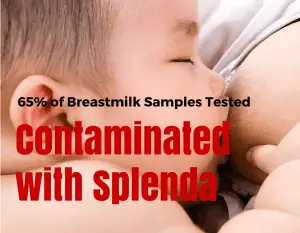By Sayer Ji
Contributing Writer for Wake Up World
A concerning new study finds that most of the breast milk samples tested contained artificial sweeteners. Why has this never been discovered until now and what are the implications to our most vulnerable populations?
Expanding on these findings, an article soon to be published in the Journal of Toxicology and Environmental Health on the presence of synthetic sweeteners in breast milk is bound to upset the apple cart when it comes to assessing the toxicological risk of these chemicals to breastfed infants.
In previous articles we have reported extensively on the dangers of artificial sweeteners, especially aspartame and sucralose (aka Splenda), whose presence in tens of thousands of consumer products make exposure to them commonplace. Despite their present day low-risk regulatory status, we have found highly concerning research that these compounds contribute to a wide range of health conditions, which include but are not limited to:
Even more concerning, when Splenda is heated at temperatures that occur in baking applications it produces dioxin, one of the most deadly chemicals known to man. This is a finding that has received almost not attention outside a few scientific studies that we reported on in an article you can familiarize yourself with here: Sucralose’s (Splenda) Harms Vastly Underestimated: Baking Releases Dioxin.
The new study titled, “Nonnutritive Sweeteners in Breast Milk“, was conducted by researchers from the National Institute for Diabetes and Digestive and Kidney Diseases, National Institutes of Health , Bethesda , Maryland , USA. The study abstract is available to read ahead of the study’s full publication later this month:
Nonnutritive Sweeteners in Breast Milk.
J Toxicol Environ Health A. 2015 Aug 12:1-4. [Epub ahead of print]
Sylvetsky AC1, Gardner AL, Bauman V, Blau JE, Martin Garraffo H, Walter PJ, Rother KI.
Abstract
Nonnutritive sweeteners (NNS), including saccharin, sucralose, aspartame, and acesulfame-potassium, are commonly consumed in the general population, and all except for saccharin are considered safe for use during pregnancy and lactation. Sucralose (Splenda) currently holds the majority of the NNS market share and is often combined with acesulfame-potassium in a wide variety of foods and beverages. To date, saccharin is the only NNS reported to be found in human breast milk after maternal consumption, while there is no apparent information on the other NNS. Breast milk samples were collected from 20 lactating volunteers, irrespective of their habitual NNS intake. Saccharin, sucralose, and acesulfame-potassium were present in 65% of participants’ milk samples, whereas aspartame was not detected. These data indicate that NNS are frequently ingested by nursing infants, and thus prospective clinical studies are necessary to determine whether early NNS exposure via breast milk may have clinical implications.
This groundbreaking study has found for the first time that sucralose and acesulfame-potassium survive maternal metabolism and enter into breast milk in the majority of the breast milk samples tested (65%). As is the case for many chemicals released into the human food supply, adequate proof of the safety of these compounds in infants is not only not available, but unethical to perform in human subjects. This is one justification for the use of surrogate risk assessments using animals, such as the animal LD50 model, whereby a chemical is tested by determining the amount needed to kill 50% of rodents within a relatively short time frame (so-called “acute toxicity”), and then deducing from that data an “acceptable level of harm” to humans primarily by adjusting for body weight differences between rodents and humans. This system, of course, is extremely primitive, and does not account for low-dose, chronic exposures; nor does it account for the synergistic toxicities of multiple exposures occurring simultaneously in real-world situations, such as the study above.
Clearly, if these artificial sweeteners are being passed directly to newborns through breast milk, and there is no assurance of their safety, an immediate halt to their use by those wishing to conceive, are pregnant, or breastfeeding should be initiated by regulators. Anything less than obeisance to the precautionary principle could be considered a violation of informed consent, and evidence of culpability shared by manufacturers and regulators to for the harm done to exposed populations.
This new study will represent something of a litmus test as far as determining how effectively the media will keep this information buried or will report accurately on it once it is released. Given the high gravitas government source of the research, and the profound implications it has to the health of our most susceptible population: newborns and infants, if it goes un- or under-reported it is our job to make sure it gets widespread exposure. Therefore please share this information and relevant links above with relevant parties and stakeholders who should be aware of the true dangers associated with the use of artificial sweeteners.
Previous articles by Sayer Ji:
- Is the Cure for Diabetes a Humble Root?
- Vegetable Extract Treats Autism Better than Pharmaceutical Drugs
- Cinnamon May Be Superior to Ibuprofen for Menstrual Pain, Study Reveals
- Coconut Water: A New Alzheimer’s Disease Treatment?
- Turmeric’s ‘Smart Kill’ Properties Put Chemo & Radiation To Shame
- 6 Evidence-Based Ways Drumming Heals Body, Mind and Soul
- Tylenol Kills Emotions As Well As Pain, Study Reveals
- Research: Plants Cure Cancer, Not Chemicals
- Beet Juice Boosts Cognitive Function In One Dose
- 13 Evidence-Based Medicinal Properties of Coconut Oil
About the author:
 Sayer Ji is an author, educator, Steering Committee Member of the Global GMO-Free Coalition (GGFC), advisory board member of the National Health Federation, and the founder of GreenMedInfo.com – an open access, evidence-based resource supporting natural and integrative modalities. His writings have been published and referenced widely in print and online, including Truthout, Mercola.com, The Journal of Gluten Sensitivity, New York Times and The Well Being Journal.
Sayer Ji is an author, educator, Steering Committee Member of the Global GMO-Free Coalition (GGFC), advisory board member of the National Health Federation, and the founder of GreenMedInfo.com – an open access, evidence-based resource supporting natural and integrative modalities. His writings have been published and referenced widely in print and online, including Truthout, Mercola.com, The Journal of Gluten Sensitivity, New York Times and The Well Being Journal.
In 1995 Sayer received a BA degree in Philosophy from Rutgers University, where he studied under the American philosopher Dr. Bruce W. Wilshire, with a focus on the philosophy of science. In 1996, following residency at the Zen Mountain Monastery in upstate New York, he embarked on a 5 year journey of service as a counsellor-teacher and wilderness therapy specialist for various organizations that serve underprivileged and/or adjudicated populations. Since 2003, Sayer has served as a patient advocate and an educator and consultant for the natural health and wellness field.
Visit GreenMedInfo online and on Facebook, or sign up for GreenMedInfo’s e-Newsletter.

If you've ever found value in our articles, we'd greatly appreciate your support by purchasing Mindful Meditation Techniques for Kids - A Practical Guide for Adults to Empower Kids with the Gift of Inner Peace and Resilience for Life.
In the spirit of mindfulness, we encourage you to choose the paperback version. Delve into its pages away from screen glare and notifications, allowing yourself to fully immerse in the transformative practices within. The physical book enriches the learning process and serves as a tangible commitment to mindfulness, easily shared among family and friends.
Over the past few years, Wake Up World has faced significant online censorship, impacting our financial ability to stay online. Instead of soliciting donations, we're exploring win-win solutions with our readers to remain financially viable. Moving into book publishing, we hope to secure ongoing funds to continue our mission. With over 8,500 articles published in the past 13 years, we are committed to keeping our content free and accessible to everyone, without resorting to a paywall.







